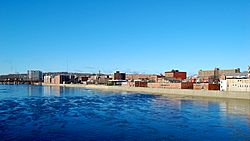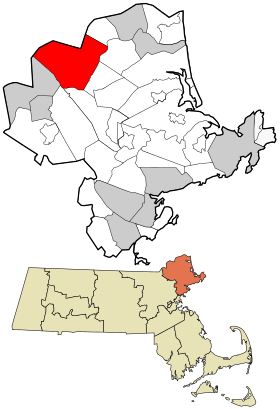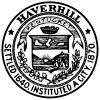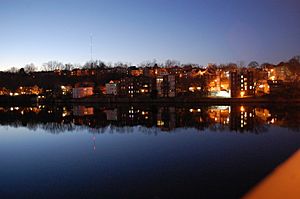Haverhill, Massachusetts facts for kids
Quick facts for kids
Haverhill, Massachusetts
|
|||
|---|---|---|---|

Haverhill from across the Merrimack River
|
|||
|
|||
| Nickname(s):
"The Queen Slipper City"
|
|||

Location in Essex County, Massachusetts
|
|||
| Country | United States | ||
| State | Massachusetts | ||
| County | Essex | ||
| Settled | 1640 | ||
| Incorporated | 1641 | ||
| Incorporated (city) | 1870 | ||
| Named for | Haverhill, Suffolk | ||
| Government | |||
| • Type | Mayor-council city (Strong Mayor) | ||
| Area | |||
| • Total | 35.70 sq mi (92.45 km2) | ||
| • Land | 33.04 sq mi (85.56 km2) | ||
| • Water | 2.66 sq mi (6.89 km2) | ||
| Elevation | 50 ft (20 m) | ||
| Population
(2020)
|
|||
| • Total | 67,787 | ||
| • Density | 2,051.91/sq mi (792.24/km2) | ||
| Time zone | UTC−5 (Eastern) | ||
| • Summer (DST) | UTC−4 (Eastern) | ||
| ZIP Codes |
01830–01832, 01835
|
||
| Area code(s) | 351/978 | ||
| FIPS code | 25-29405 | ||
| GNIS feature ID | 0612607 | ||
Haverhill (pronounced HAY-vril) is a city in Essex County, Massachusetts, United States. It is located about 35 miles (56 km) north of Boston. Haverhill is also close to the New Hampshire border and about 17 miles (27 km) from the Atlantic Ocean. In 2020, about 67,787 people lived there.
Haverhill is located on the Merrimack River. It started as a farming community for Puritans from Newbury Plantation. The land was bought from the Pentucket people in 1642. The town was first called Pentucket. Later, it was renamed Haverhill, after a town in England. This was the hometown of the Ward family, who were early settlers.
Haverhill grew into an important industrial city. It started with sawmills and gristmills powered by water. In the 1700s and 1800s, it became known for woolen mills, tanneries, shipping, and shipbuilding. For many years, Haverhill was a major center for making shoes. By 1913, one-tenth of all shoes made in the United States came from Haverhill. Because of this, it was known as the "Queen Slipper City."
Contents
A Look at Haverhill's Past
Haverhill has been part of many important moments in American history. This includes the first colonial settlements, the French and Indian Wars, and the Revolutionary and Civil wars.
Early Days: The 1600s
The town was founded in 1640 by settlers from Newbury. It was first called Pentucket, which is a Native American word meaning "place of the winding river." Early settlers bought the land from Native American chiefs Passaquo and Saggahew. They also had permission from Passaconaway, chief of the Pennacook people.
Some early settlers were John Ward, Robert Clements, and Tristram Coffin. They helped buy the land. The town was renamed Haverhill after the English hometown of its first pastor, Rev. John Ward. The first settlement was near Water Street and Mill Street. The home of William White, one of the city's founders, is still standing today.
Judge Nathaniel Saltonstall from Haverhill was chosen to lead the Salem Witch Trials in the 1600s. However, he did not agree with the trials and left. Historians believe his decision helped prevent the witch hysteria from becoming as bad in Haverhill as it was in nearby Andover. Still, some women from Haverhill were accused of witchcraft.
One of the first settlers, Tristram Coffin, ran an inn. He left Haverhill in 1659 to help start the settlement at Nantucket.
Haverhill was a frontier town for many years. It sometimes faced attacks from Native Americans and French colonial troops. During King William's War, Hannah Duston became well-known. She was captured in 1697 and escaped by fighting her captors. Haverhill has the first statue in the United States built to honor a woman. This statue, built in the late 1800s, shows Hannah Duston. Her story of escape and revenge was written about by Cotton Mather. However, her actions remain a topic of discussion today.
Growing Up: The 1700s
In 1708, during Queen Anne's War, the town was attacked by French, Algonquin, and Abenaki Native American groups.
Like many towns, Haverhill faced several epidemics. For example, Diphtheria caused the deaths of 256 children in Haverhill between 1735 and 1737.
George Washington visited Haverhill on November 4, 1789. He was on a tour of New England at the time.
The 1800s: Industry and Change
Bradford Academy was founded in 1803. It started for both boys and girls, then became an all-girls school in 1836.
In 1826, the town was affected by influenza. A group that promoted avoiding alcohol, called a temperance society, was formed in 1828.
Haverhill residents were early supporters of ending slavery. The city still has houses that were part of the Underground Railroad. This was a secret network that helped enslaved people escape to freedom. In 1834, a local branch of the American Anti-Slavery Society was started. Poet John Greenleaf Whittier was also a strong supporter of ending slavery.
The Haverhill and Boston Stage Coach company operated from 1818 to 1837. It stopped when the railroad reached Haverhill.
Ezekiel Hale Jr. and his son Ezekiel James Madison Hale were very important to Haverhill's growth. In 1835, they built a brick factory that made woolen flannel. When a fire destroyed it in 1845, Ezekiel J.M. Hale rebuilt it even bigger. He became a very successful businessman in Haverhill. He also gave a lot of money to build the local hospital and library.
Haverhill officially became a city in 1870.
On February 17, 1882, a huge fire destroyed a large part of the city's mill area. The fire covered over 10 acres (4 hectares). Firefighters had trouble because their equipment was old, and there were strong winds and freezing temperatures. The nearby Merrimack River was frozen, making it hard to get water. A newspaper reported that 300 businesses were destroyed, with damages around $2 million (in 1882 money).
Bradford Joins Haverhill
Bradford and Haverhill were separate towns until January 1, 1897, when Bradford became part of Haverhill. Bradford was originally the western part of Rowley. In 1850, the eastern part of Bradford became the town of Groveland.
People started talking about Bradford joining Haverhill after Haverhill became a city in 1870. It took 26 years for both towns to agree. Many reasons led to this decision. People in Bradford who had businesses in Haverhill wanted lower taxes. Some people wanted Haverhill to be a "dry town" (where alcohol sales are restricted), like Bradford was. Businesses in nearby cities also wanted Haverhill to be dry to attract more customers to their towns.
Also, Haverhill had important services like hospitals, schools, and new factories that Bradford did not. The center of Bradford wanted to join Haverhill, but the Ward Hill section was further away and less sure.
Another reason Haverhill wanted to annex Bradford was to increase the number of English residents. Many new mill workers were from Ireland, French Canada, and Central Europe. Haverhill approved the merger in 1870, and Bradford officially joined on January 1, 1897. Bradford is the only town in Massachusetts to be annexed by a neighboring city other than Boston.
Haverhill became the first American city to elect a socialist mayor in 1898. His name was John C. Chase, a former shoe factory worker. He was re-elected in 1899 but lost the next year.
The 1900s: Challenges and Changes
In 1926, Haverhill was the site of a disease called Haverhill fever, also known as rat-bite fever.
In the early 1900s, Haverhill's factories faced problems because of cheaper goods from other countries. The Great Depression made the economic situation worse. In the 1950s and 1960s, city leaders decided to use "urban renewal" plans. They received money from the government to tear down many old buildings downtown. This included many historic homes and important buildings like the Old City Hall. Many of the city's famous buildings were lost.
During urban renewal, the historic high school, which inspired Bob Montana's Archie Comics, was almost torn down. Instead, the old City Hall was demolished, and the high school building became the new City Hall.
Urban renewal was a debated topic. Some citizens wanted to save the old buildings instead of tearing them down. However, Haverhill chose to demolish much of its historic downtown. Still, you can find examples of old architecture in the city. These include colonial houses and Victorian mansions from Haverhill's shoe manufacturing boom.
Modern Times: The 2000s
In the 21st century, downtown Haverhill has been improving. Old factories have been turned into loft apartments and condominiums. This has brought over $150 million in public and private investments to the downtown area. The Washington Street area now has new restaurants and entertainment spots. A new parking garage was built on Granite Street. The city also added a new boardwalk and boat docks downtown.
Recently, the city made plans to redevelop "Whites Corner." This involved tearing down the vacant Woolworth building and other nearby structures. They are being replaced by a new project called Harbor Place, which will have mixed uses, including housing.
Haverhill's Location and Features
Haverhill has a total area of about 35.7 square miles (92.3 square kilometers). About 33.0 square miles (85.4 square kilometers) is land, and 2.66 square miles (6.9 square kilometers) is water. It is the largest city or town in Essex County by land area.
The city is crossed by the Little River and the Merrimack River. The Merrimack River separates the Bradford section of town from the rest of Haverhill. The highest point in the city is Ayers Hill. Haverhill also has several ponds, lakes, and three golf courses.
Haverhill shares borders with several towns. These include Merrimac to the northeast, West Newbury and Groveland to the east, and Methuen to the southwest. It also borders towns in New Hampshire to the north.
Places to Visit
- Main Street Historic District
- Trinity Stadium (formerly Haverhill Stadium)
- Haverhill tower clock at Walnut Square School
- Tattersall Farm
- Winnekenni Park Conservation Area, which includes Winnekenni Castle and Lake Saltonstall
- Downtown Haverhill, with many restaurants, docks, and boardwalks along the Merrimack River
People of Haverhill
| Historical population | ||
|---|---|---|
| Year | Pop. | ±% |
| 1790 | 2,408 | — |
| 1800 | 2,730 | +13.4% |
| 1810 | 2,682 | −1.8% |
| 1820 | 3,070 | +14.5% |
| 1830 | 3,896 | +26.9% |
| 1840 | 4,336 | +11.3% |
| 1850 | 5,877 | +35.5% |
| 1860 | 9,995 | +70.1% |
| 1870 | 13,092 | +31.0% |
| 1880 | 18,472 | +41.1% |
| 1890 | 27,412 | +48.4% |
| 1900 | 37,175 | +35.6% |
| 1910 | 44,115 | +18.7% |
| 1920 | 53,884 | +22.1% |
| 1930 | 48,710 | −9.6% |
| 1940 | 46,752 | −4.0% |
| 1950 | 47,280 | +1.1% |
| 1960 | 46,346 | −2.0% |
| 1970 | 46,120 | −0.5% |
| 1980 | 46,865 | +1.6% |
| 1990 | 51,418 | +9.7% |
| 2000 | 58,969 | +14.7% |
| 2010 | 60,879 | +3.2% |
| 2020 | 67,787 | +11.3% |
| 2022* | 67,153 | −0.9% |
| * = population estimate. Source: United States Census records and Population Estimates Program data. Source: |
||
In 2010, there were 60,879 people living in Haverhill. The city had 25,576 households. About 88.3% of the people were White, and 14.5% were Hispanic or Latino. Many residents have Irish, Italian, French, or English backgrounds.
About 25.7% of the population was under 18 years old. The median age was 36 years. The median income for a household in the city was about $49,833.
Learning in Haverhill
Haverhill is home to the main campus of Northern Essex Community College. Until 2000, Bradford College was also in Haverhill. In 2007, the Zion Bible College, now called Northpoint Bible College, moved to Haverhill. The University of Massachusetts Lowell also has a campus in the Harbor Place building and offers courses at Northern Essex Community College.
Haverhill recently rebuilt the Hunking middle school in the Bradford area. The city also has the historic Walnut Square School, built in 1898. Its tower clock was made by a famous clock maker, Mr. Edward Howard.
Public schools in the city are run by the Haverhill Public Schools District.
Getting Around Haverhill
Haverhill is located along Interstate 495, which has five exits in the city. Five state routes also cross the town: Routes 97, 108, 110, 113, and 125.
There are six road crossings and one rail crossing over the Merrimack River in Haverhill. These include two I-495 crossings, the Comeau Bridge, the Basiliere Bridge, the Bates Bridge, and the Rocks Village Bridge. A project began in 2010 to replace the Bates Bridge with a new, modern one.
The MBTA Commuter Rail offers train service from Boston's North Station to the Haverhill and Bradford stations. Amtrak also provides service to Portland, Maine, and Boston from the Haverhill station. Local bus service is provided by the MVRTA.
The closest small airport is Lawrence Municipal Airport in North Andover. The nearest major airport is Manchester-Boston Regional Airport in Manchester, New Hampshire. The closest international airport is Logan International Airport in Boston.
Internet service is available from Comcast Communications (XFINITY) and Atlantic Broadband (Breezeline).
Famous People from Haverhill
Many notable people have connections to Haverhill, including:
- Alexander Graham Bell (1847–1922), the inventor of the telephone, spent time in Haverhill.
- John Bellairs (1938–1991), author of gothic horror books for children and young adults.
- Tom Bergeron (born 1955), a television personality and game show host.
- Tristram Coffin, one of the town's first settlers, who later helped found Nantucket.
- Hannah Duston (1657–1736), a colonial figure, honored with the first statue of a woman in the U.S.
- Sylvia Hitchcock, Miss USA 1967 and Miss Universe 1967.
- Rowland H. Macy (1822–1877), a merchant who founded Macy's department store.
- Louis Burt Mayer (1884-1957), a film producer and co-founder of Metro-Goldwyn-Mayer (MGM) studios.
- Bob Montana, co-creator of Archie Comics.
- William Henry Moody (1853–1917), a Supreme Court justice.
- James E. Rothman, a cell biologist and Nobel Prize winner.
- Nathaniel Saltonstall (1639–1707), a judge at the Salem witch trials.
- John Greenleaf Whittier (1807–1892), a famous poet.
- Rob Zombie (born 1965), a musician and film director.
See also
 In Spanish: Haverhill (Massachusetts) para niños
In Spanish: Haverhill (Massachusetts) para niños






